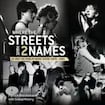
Citizen photographers are everywhere these days, Instagramming this or Snapchatting that with their smartphones, but in the late 1970s, when mechanical cameras were used to capture moving images for posterity, photography was more of a challenge. And few people attending gigs in and around Dublin at the time would have expected the mostly shambolic rock bands playing in often dank venues to be remembered, let alone still be around.
Patrick Brocklebank was there, however, with his Konica SLR, mooching around venues such as McGonagles, Project Arts Centre, TCD Buttery, Olympic Ballroom, TV Club, Magnet Bar, National Stadium, Top Hat Ballroom and Stardust Ballroom.
Brocklebank was, you might say, in the right place at the right time – and, indeed, in the right frame of mind – because during this period Irish rock music shifted on its axis. The unwieldy title of his photographic memoir more or less gives the story away, but we're guessing that the mention of U2 in the title and images of the band on the cover – as well as the obvious reference to one of the band's best-known songs – is more a marketing decision than anything else, as it could as validly have been called The Dublin Music Scene and U2, 1978-81.
For all that, the photographs (and the all-too-brief text by editor Sinéad Molony) tell their story. It's important to emphasise that Brocklebank was no mere interloper. As a music fan and a graphic artist and freelance photographer for In Dublin and Hot Press magazines, and for the start-up Sunday Tribune, he knew the city's punk bands, hung out with them, and photographed them at gigs, backstage, offstage and at house parties. There is a clear sense that some were taking it all very seriously (yes, that's U2), some were chancing their dadaist arms (that'd be Virgin Prunes), a few were enjoying short, sharp epiphanies, and many were simply having a laugh and then moving on.
Yet, for each experience, Brocklebank is there, capturing not only the bands but also the barely-there infrastructure: pirate radio stations (Big D, ARD, Capitol Radio), fanzines (Heat), a Mountjoy Square squat (where the likes of U2, Boy Scoutz and Schoolkids rehearsed), and a hastily convened replacement venue (Leixlip Castle) for a homecoming gig in March 1980 by The Boomtown Rats, whose original gig at Leopardstown Racecourse some weeks before had been controversially cancelled. The book ends with images of U2 at Slane Castle in 1981, when Thin Lizzy not so much threw down the gauntlet as passed on the baton.
Infrastructurally, at least, we know what happened next: the rise of U2, the reach of 2FM, the presence of Hot Press. All hail the faltering baby steps of an emerging, culturally appreciative indigenous music industry. Wisely, Brocklebank decides not to go there, leaving us reasonably secure in the knowledge that what took place prior to 1981 was equally important.
The book contains hundreds of images, most of which are instructive but only a few handfuls of which could be said to be compositionally strong. These include The Ramones’ aural rampage at the State Cinema in Phibsborough in 1978; the original three-piece Blades at Canal Banks on a hot summer day in 1979; an outside shot of McGonagles on South Anne Street; and U2’s Edge, hair intact, leaving a party, in 1978.
What Brocklebank has ultimately done here, however, is historically crucial: he has captured and highlighted a pivotal period in Irish rock music. From this point on it really was, in the immortal words of The Ramones, hey ho, let’s go.
Tony Clayton-Lea writes on pop culture and art for The Irish Times.














